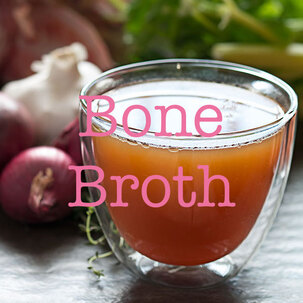
Bone Broth is as its name implies. It boasts a long list of purported health benefits:
function, and aiding metabolism. Here's more about what's found in bone broth:
TIP: It is important to know your food sources, and this is especially important when making bone broth at home. You don't want to create this potentially health promoting Winter staple using animals that were raised non-organic or inhumanely. In Maine, we are lucky that it is possible to know your farmer. Animal CSAs and small scale butchers are also possible to find. Make the health of the animals a priority, and improve your impact on global health by reducing meat intake and using the entire animal, in exchange for quality of their lives and quality of your food.
Here's the slow-cooker recipe for 10 cups of broth:
2 Lb beef bones
10 c water
3 carrots
2 celery stalks
2 onions
3 cloves garlic
2-3 bay leaves
1/8 c. ACV (apple cider vinegar)
optionl:
1/2 tsp salt
1/2 tsp whole peppercorns
a few sprigs of parsley & thyme
Coarsely chop the vegetables.
Add all ingredients into your slow cooker, turn heat to high until it reaches boiling. Then reduce to medium heat and simmer for 24-48 hours. Periodically chekc the water levels to ensure you have not run dry. The longer it simmers, the more nutrients you'll leech.
Strain the solids out and enjoy.*
*Side note: You can consume your broth immediately, or let it cool and skim the fat off the surface. (Fat may be later used for frying or roasting.) Refrigerate your broth and consume within 7 days, or freeze up to 3 months. Freezing in small batches, like ice cube trays, allows you to add small amounts to your Winter soups.
- Bioavailable delivery of vitamins and minerals, some of which are not obtained easily
- elsewhere
- All those nutrients promote joint health
- Used in healing leaky gut syndrome- important for those suffering with various
- digestive issues
- Replenishes the digestive system by nourishing the right digestive flora
- Immune boosting!
function, and aiding metabolism. Here's more about what's found in bone broth:
- Glucosamine reduces inflammation, arthritis and joint pain
- Collagen is essential for healthy cell regeneration as well as joint health
- Gelatin maximizes satiety: Replacing one meal a day with a cup of broth, as part of a comprehensive health management program, can help you feel full longer; bone broth may also be sued to boost your soups
- Glycine is known for having caling effects, which may help to achieve better sleep
- And, bone broth is a great source of all the essential amino acids, and trace minerals
TIP: It is important to know your food sources, and this is especially important when making bone broth at home. You don't want to create this potentially health promoting Winter staple using animals that were raised non-organic or inhumanely. In Maine, we are lucky that it is possible to know your farmer. Animal CSAs and small scale butchers are also possible to find. Make the health of the animals a priority, and improve your impact on global health by reducing meat intake and using the entire animal, in exchange for quality of their lives and quality of your food.
Here's the slow-cooker recipe for 10 cups of broth:
2 Lb beef bones
10 c water
3 carrots
2 celery stalks
2 onions
3 cloves garlic
2-3 bay leaves
1/8 c. ACV (apple cider vinegar)
optionl:
1/2 tsp salt
1/2 tsp whole peppercorns
a few sprigs of parsley & thyme
Coarsely chop the vegetables.
Add all ingredients into your slow cooker, turn heat to high until it reaches boiling. Then reduce to medium heat and simmer for 24-48 hours. Periodically chekc the water levels to ensure you have not run dry. The longer it simmers, the more nutrients you'll leech.
Strain the solids out and enjoy.*
*Side note: You can consume your broth immediately, or let it cool and skim the fat off the surface. (Fat may be later used for frying or roasting.) Refrigerate your broth and consume within 7 days, or freeze up to 3 months. Freezing in small batches, like ice cube trays, allows you to add small amounts to your Winter soups.

